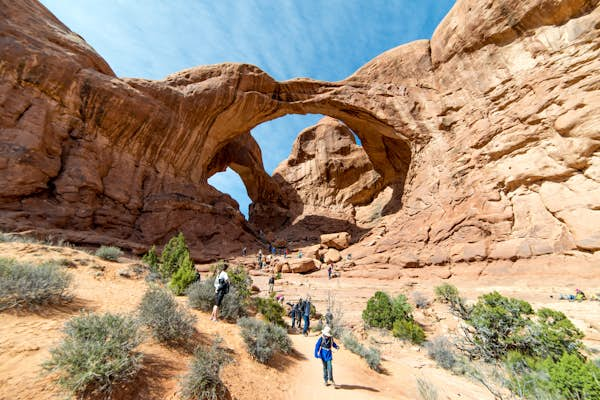At a time when many of us are isolated in our homes and encouraged to stay more than 6ft away from others when we do go outside, it’s tempting to dream of the wide-open spaces, beautiful landscapes and challenging trails provided by so many national parks in the United States. But the global and local effects of COVID-19, the disease caused by the novel coronavirus, are much more complicated than simply getting into your car and setting out for a campsite.

“Living in Moab, I originally thought we’d be a bit protected from the impact of coronavirus because we’re so isolated,” says Abbi Hearne, a Utah-based adventure photographer who has been vocal on her Instagram about the impact of COVID-19 on her community. “But as spring break season began, I realized it was the opposite. We saw a huge flood of tourists this week coming in from all over the country and the numbers only grew as other spring break plans, such as skiing in Colorado, were cancelled due to the virus.”
Moab, Utah is the launching point for visitors to many popular parks, including Arches and Canyonlands, and in recent days the small city has received an influx of visitors. According to a report from the Salt Lake Tribune, occupancy at area hotels is already at 80 percent and with only 17 beds and two respirators available at the small hospital, an outbreak of the virus could spread rapidly and quickly overwhelm Moab’s limited medical resources.
The Utah Department of Health issued an order prohibiting new visitors from camping in the parks, but the expanse and isolation of the area makes it difficult for parks employees to monitor.
Visitors practicing “social distancing” arrive to small towns
“Our local population is 15 percent elderly, and we are still seeing thousands of out-of-town travelers,” says Hearne. “The reality is similar for most gateway towns to our national parks. Increased visitation in the name of social distancing is dangerous for these small towns as well as national park employees. I have friends who live and work in Yosemite Valley who are afraid for their lives should they experience an outbreak from tourists – they don’t have a hospital in the valley.”
Impacts on indigenous groups
In eastern California, the Owens Valley – also called Payahǖǖnadǖ – is a popular site for fishing, hiking, camping and climbing, and has also been a destination for many visitors eager to escape the confines of homebound isolation. But those people are ignoring the danger in which they’re putting the area’s residents, says Jolie Varela, founder of Indigenous Women Hike and citizen of the Tule River Yokut and Paiute Nations.
“I’m seeing on Instagram and Facebook that people are literally talking about escaping, about coming here to get away and just to go camping,” Varela says. “But I think people are not taking into consideration how that could be limiting resources for the people here.” The strain on local stores has been enormous, Varela says, as visitors stockpile necessities on their way home, leaving nothing for residents. “It’s pretty disheartening that our community doesn’t even have what they need here. And we live here year-round and also as indigenous people, we’ve always been here and we will always be here.”
The effects of coronavirus could be particularly calamitous for the indigenous population because of its increased mortality rate among the elderly. “We have a very vulnerable population and our elders hold our ceremonies and our traditions and our language,” Varela says. “They’re the culture bearers in our community and they’re the ones who are most vulnerable. If the virus comes in and affects our elders it would have a devastating toll on our community. That’s our knowledge right there. And we still have so much to learn from our knowledge keepers.”

Visitors strain park resources
In addition to affecting local communities, visiting national parks during the COVID-19 outbreak puts increased pressure on already-strained park resources and employees, who are then at a greater risk of being exposed to the virus. The Coalition to Protect America’s National Parks, a group comprising former national parks employees, called for the National Parks Service to close “all facilities that require employees and/or members of the public to be in close proximity in confined spaces.” Some parks – like the Washington Monument and Ellis Island – have already been closed to the public, while others – like Big Bend National Park and Crater Lake National Park – have closed their visitors centers and other points of contact. But the majority remain open and must be staffed and maintained accordingly.
People who live in areas without a shelter-in-place order are still allowed to leave their homes to go for a run or to take the dog for a walk around the neighborhood, though practicing social distancing while you’re outside is still essential to stop the spread of the virus. Some cities that have sufficient medical capabilities and supplies are even encouraging spending some time outdoors to ward off cabin fever. But resist the temptation to set out for more isolated areas, where resources are already stretched thin and vulnerable communities could be put at additional risk by your actions.
“The parks are going to be here in the future when people are well,” says Varela. “Your adventure can wait.”
The novel coronavirus (COVID-19) is now a global pandemic. Find out what this means for travelers.
You might also like:
Ask Tom: Lonely Planet expert answers your pressing travel questions in light of the coronavirus pandemic
How Airbnb has updated its cancellation policy for the coronavirus

